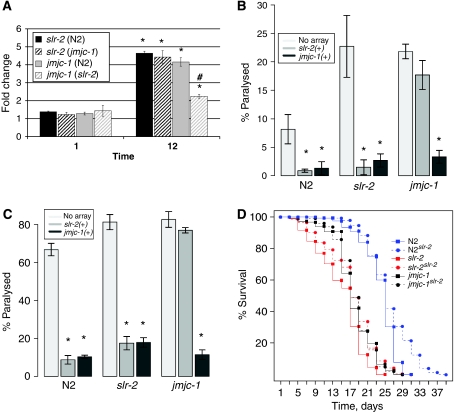Figure 6.
SLR-2–JMJC-1 overexpression and epistasis analysis. (A) qRT–PCR data for slr-2 and jmjc-1 from heat-shocked slr-2(ku297), jmjc-1(tm3525), and wild-type (N2) strains. Note that full induction of jmjc-1 requires wild-type slr-2, whereas slr-2 expression was not dependent on jmjc-1. Asterisks in (A) indicate P<0.01 as compared with non-stressed genotypic cohorts; hash sign in (A) indicates attenuation of upregulation of jmjc-1 in stressed slr-2 mutants as compared with stressed wild type (P<0.01). (B–C) Wild-type (N2), slr-2(ku297), and jmjc-1(tm3525) worms carrying either no extra-chromosomal array or arrays containing multiple copies of either slr-2 or jmjc-1 were subjected to a 12 h ethanol (induced by 4% ethanol-supplemented NGM) (B) or oxidative (induced by 160 mM juglone-supplemented NGM) (C) stress and scored for paralysis. Asterisks in (B) and (C) indicate statistical significance, P< 0.001. Each bar in (B) and (C) represents data for 150 animals. Although all three strains showed significant rescue with the extra-chromosomal array encoding jmjc-1, the slr-2 extra-chromosomal array only showed rescue or enhanced survival in slr-2 and wild-type (N2) strains, further indicating that SLR-2 functions upstream of JMJC-1. (D) Survival curves of wild type (N2), slr-2(ku297), and jmjc-1(tm3525) with and without the slr-2 high-copy extra-chromosomal array. Worms were placed at 20°C on NGM plates and scored every other day for survival. In N2 and slr-2 strains, the slr-2 extra-chromosomal array conferred a modest, but statistically significant, increase in lifespan (P<0.001).

